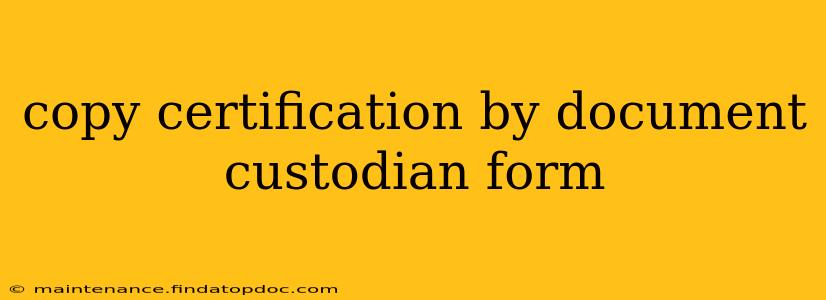Obtaining a certified copy of a document often requires a formal process involving a document custodian. This guide explains the importance of certified copies, the role of the custodian, and how to create a comprehensive certification form. We'll also address frequently asked questions surrounding this vital process.
What is a Certified Copy?
A certified copy is a reproduction of an original document that's formally declared as a true and accurate representation of the original. The certification adds legal weight and trustworthiness, making it acceptable for various official purposes where a simple photocopy would be insufficient. This is especially critical for legal documents, financial records, academic transcripts, and other materials requiring verification.
The Role of the Document Custodian
The document custodian is the individual or entity responsible for the safekeeping and management of original documents. This responsibility often carries legal and ethical obligations. Custodians can range from individual record-keepers to entire departments within organizations. Their certification verifies the authenticity of the copy, confirming its accuracy and origin.
Creating a Comprehensive Copy Certification Form
A well-structured copy certification form ensures clarity and leaves no room for ambiguity. Key elements to include are:
- Identification of the Document: Clearly state the document type (e.g., "Birth Certificate," "Contract Agreement"), date of issuance, and any identifying numbers or codes.
- Description of the Copy: Specify the type of copy (e.g., "photocopy," "scanned image") and its method of reproduction.
- Certification Statement: This is the crucial part. It should explicitly state that the copy is a true and accurate representation of the original document, and that the custodian has examined both.
- Custodian Information: Include the full name, title, contact information, and signature of the document custodian. For organizations, a company stamp or official seal might also be required.
- Date of Certification: The date the certification was signed and issued is essential for verification.
- Witness Signature (Optional): While not always mandatory, an additional witness signature can further strengthen the certification's legitimacy.
Example Copy Certification Form
While a specific form will vary based on the organization and the type of document, a general example could look like this:
COPY CERTIFICATION
I, [Custodian's Full Name], [Custodian's Title] of [Organization Name], certify that the attached copy of [Document Type], dated [Date of Document], with [Identifying Number/Code], is a true and accurate reproduction of the original document in my custody.
Signature Date
Printed Name
Title
Contact Information
How to Obtain a Certified Copy
The process of obtaining a certified copy typically involves:
- Requesting a Copy: Contact the document custodian and request a certified copy. You may need to provide identification and possibly pay a fee.
- Verification: The custodian verifies the document's authenticity and prepares a certified copy.
- Issuance: The custodian will provide you with the certified copy along with the completed certification form.
Frequently Asked Questions (FAQs)
What is the difference between a certified copy and a simple photocopy?
A certified copy is officially declared as a true representation of the original, backed by the custodian's certification. A simple photocopy has no such verification.
Is a certified copy legally binding?
Yes, a certified copy carries the same legal weight as the original document, provided it's properly certified by the authorized custodian.
Who can act as a document custodian?
The individual or entity legally responsible for managing and maintaining the original document. This often depends on the context (e.g., government agencies, companies, educational institutions).
Can I create my own certified copy?
No. Self-certification is typically not accepted. The certification must be provided by the authorized custodian of the original document.
This comprehensive guide clarifies the process and importance of obtaining certified copies and provides a framework for a thorough and effective copy certification form. Remember to adapt this information to fit the specific requirements of your situation. Always consult legal counsel if you have doubts about the legal validity of a specific certification.
